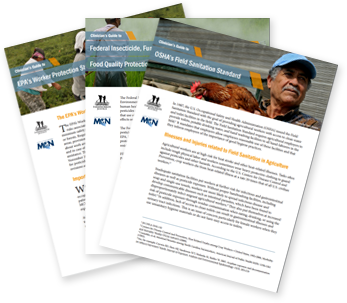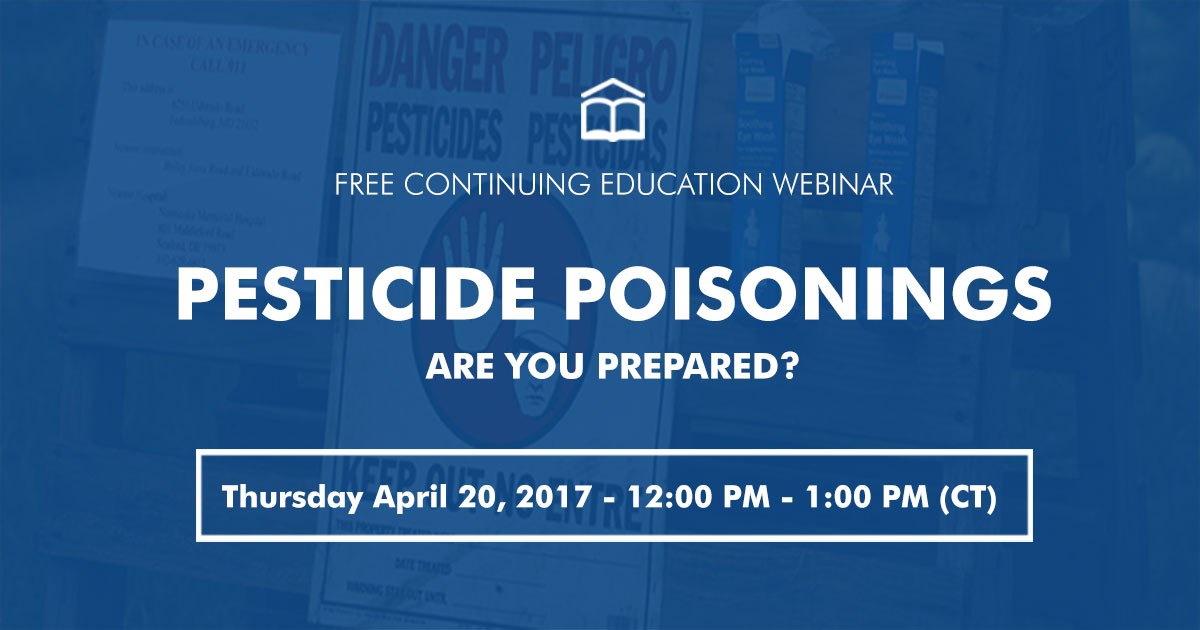- Who We Are
- Clinician Employment
- Publications
- Witness to Witness (W2W)
- El Premio Kugel & Zuroweste a la Justicia en la Salud
- Your Voice Matters: Photovoice Project
Cholinesterase (ChE) Testing Protocols and Algorithm for Healthcare Providers
These Cholinesterase (ChE) clinical tools provide a concise and simple format to guide clinicians in monitoring the ChE levels for patients working with Class I and Class II organophosphates (OP) or OP and N-methyl-carbamates.
Files
-
- Cholinesterase Algorithm ( 707 Kb )
-
- Cholinesterase Protocols ( 173 Kb )
-
- Protocolos de Colinesterasa (ESP) ( 587 Kb )
-
- Algoritmo de Colinesterasa (ESP) ( 173 Kb )
National Pesticide Practice Skills Guidelines for Medical and Nursing Practice
Outlines the knowledge and skills that health professionals need to have about pesticides. This document is part of a national initiative aimed at ensuring that pesticides issues become integral elements of education and practice of primary care providers. English and Spanish
Files
-
- NEETFPesticidePracticeGuidelines ( 2 Mb )
-
- NEETFHabilidadesParaLaPracticaPesticidas ( 684 Kb )
Webinar | Pesticide Poisonings - Are you prepared? (April 2017)
Guías para ayudar a los médicos en la comprensión de regulaciones de salud y seguridad de los campesinos

Files
-
- OSHA's Field Sanitation Standard Clinician's Guide ( 765 Kb )
-
- FIFRA FQPA Clinician's Guide ( 295 Kb )
-
- WPS Clinician's Guide ( 864 Kb )
Fact Sheet- Key Revisions to the Worker Protection Standard
The U.S. Environmental Protection Agency’s (EPA) Worker Protection Standard (WPS) provides basic workplace protections to farmworkers and pesticide handlers to minimize the adverse effects of pesticide exposure. EPA announced major revisions to the WPS in September 2015. MCN and FJ's fact sheet provides a summary of the revised regulation.
Files
-
- Fact Sheet-Revisions to WPS ( 1 Mb )
Preventing Agricultural Pesticide Exposure: Revisions to the EPA’s Worker Protection Standard
In 2015, for the first time in over 20 years, the Environmental Protection Agency updated the Worker Protection Standard (WPS). The WPS provides basic workplace protections for agricultural workers to reduce the risk of pesticide exposre. This issue brief overviews the major revisions that are particularly relevant for clinicians caring for agricultural workers.
Files
-
- WPS Issue Brief 2016 ( 3 Mb )
Environmental and Occupational Health Screening Questions for Primary Care
Three concise and effective environmental/occupational health screening questions for the primary care provider. English and Spanish. MCN, 2014.
An EHR-friendly version of these screening questions was developed through MCN's Workers & Health Program. This can be used as a reference for integration into the health center's Electronic Health Record.
EPA's New Pesticide Resource Includes Expanded Content, Features MCN
Wed, 09/11/2013 | by mpiorunskiYour patient reports stomach pain, nausea and headache. It’s nearing the heart of flu season - these are possible flu symptoms, you think. On examination, the patient doesn’t present with a fever.
“Is anyone at home sick?” you ask.
No.
“When did the symptoms begin?”
Hoy (Today).
You notice the patient appears to be dressed for work. “Where were you when the symptoms began?” you ask.
En el trabajo (At work).
At work, you think. “And what do you do for work?”
Assessment of Maternal Occupational Pesticide Exposures during Pregnancy and Three Children with Birth Defects: North Carolina, 2004
Introduction
In August of 2005, the North Carolina Division of Public Health, Occupational and Environmental Epidemiology Branch (OEEB) was notified that three women who had worked on farms in North Carolina owned by Ag-Mart had delivered infants with birth defects. All three births took place in Florida where the women also worked on Ag-Mart farms and lived near each other. This report summarizes the OEEB’s investigation and assessment of the pesticide exposures likely experienced by these women while in North Carolina.
Files
-
- Ag-Mart Release Report ( 203 Kb )
Occupational Exposure to Hazardous Agents
Haz-Map® is an occupational health database designed for health and safety professionals and for consumers seeking information about the adverse effects of workplace exposures to chemical and biological agents. The main links in Haz-Map are between chemicals and occupational diseases. These links have been established using current scientific evidence.





